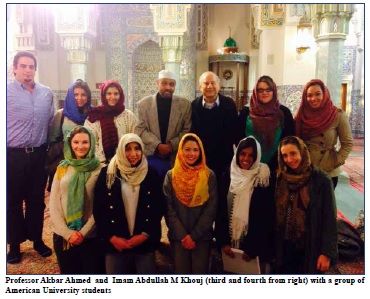When Divides Dissolve, Togetherness Begins
By Pawan Bali
American University
Washington, DC

We all sat in a circle, surrounded by the tranquility of a richly decorated mosque in Washington DC. We were for once away from all schisms - of religion, faith and nations. Ten American students, a Pakistani professor and an Indian journalist - we all sat in a circle to explore the space where divides end, and togetherness begins.
This was not new for Professor Akbar Ahmed, a former Pakistani Ambassador and a reputed scholar of Islam, who had been a force behind the interfaith dialogue in Washington DC after 9/11. For his students at American University, the experience was a novel one -for most of them, it was their first ever visit to a mosque. Our group was a concoction of identities - Native Americans, Roman Catholics, Moroccan Jews, and I, a Sikh from the Indian side of Kashmir.
The visit was scheduled to give students, from Professor Ahmed’s popular World of Islam class at American University, an experience of a mosque and to clear misperceptions about clashes of faiths. We chose to visit the Islamic Center in DC, a mosque designed by an Italian architect and constructed in the fifties. The Imam at the Center led us through the prayers and explained the three categories in Islam - a Muslim, who may or may not be truly spiritual; a Momim, a believer who practices his belief faithfully; and the highest category of a Muhsin, who is benevolent, charitable and a humanitarian to all mankind. For him, spreading education or ilm met with the highest category - a reason why he often addressed Professor Akbar Ahmed as Muhsin. Imam Abdullah M Khouj, who is from Mecca, became a Hafiz, or someone who memorizes the entire Qur'an, at the age of 11. He clearly held high reverence for scholarship and service, perhaps even greater than just practicing beliefs.
Imam Khouj, who has been the head of the mosque for over 30 years, was refreshingly candid and admirably patient. He discussed how Islam teaches a respect for differences, “ If God wanted all of us to be the same, He would have made us the same”. For most of us, who were not so familiar with the Qura’nic verses, he quoted a verse, “ To you your religion and to me mine”. Clearly, a phrase missed out in the entire “clash of civilization” debate.
For the students, the experience was varied. For some it was humbling. For others, enlightening - a reminder of how similar, yet different the ways of God are.
Casey Wilson, a Catholic American, says it was just a reminder of the similarities between Christianity and Islam. “ They may have different pillars and practices, but the passionate belief in God resonates”, she says.
Lareina Montoyo, a Mohawk from Six Nations, left the mosque with these similarities bundled up with her. “We, the Native Americans, do not call our traditions a religion, but rather view it as a way of life. We have always been taught tolerance, community service and to contribute towards the larger good of the mankind - the ideas which are very similar to what I heard at the mosque,” says Montoyo.
While the similarities were celebrated, the differences were respected. Sandra Mekler, a Jew from Morroco says, “As a Jew, I was taught that we did not bow, as we did not idolize. But when I saw the prayers, as men bowed and prostrated together in perfect unison, I thought it was a touching act of humbleness.” “Shoeless, modest and humble,” she sums it up.
In the mosque, under the magnificent bronze Egyptian chandelier, we sat together in a circle as teachers and learners. We discussed why women pray in separate spaces, why religions have sectarian divides. We explored how humility and submission are at the core of spirituality, how various faiths were connected with a common thread.
When we were about to leave, I turned to Imam Khouj and told him that the holy text of the Sikhs, the Guru Granth Sahib, repeats the name Allah 46 times. Professor Ahmed reiterated that the fifth Sikh Guru asked a Muslim Sufi saint, Mian Mir, to lay the foundation stone of the Holiest Sikh shrine, the Golden Temple in Amritsar. Here we were, a Pakistani professor, an Indian journalist and ten American students, attempting to find bridges between faiths. My mind raced back to the raging battles between nations, to the gunfire on the borders, to attacks on places of worship, to condemnation in the name of faith. Far away from these clashes, here we were as a small group, dissolving divides that we had known, finding common spaces.
As we all walked out of the mosque on a sunny autumn afternoon, I could only hope that this microcosm of togetherness spreads around. That we all begin by seeing a part of ourselves in the “other”. It was a bright, warm autumn afternoon. We said a little prayer. For warmth. And, for togetherness
(Pawan Bali is an Indian journalist and is currently pursuing her Master's in International Peace and Conflict Studies at American University, Washington DC. She has worked with the Indian news channel CNN-IBN and the Indian Express newspaper)
Back to Pakistanlink Homepage

